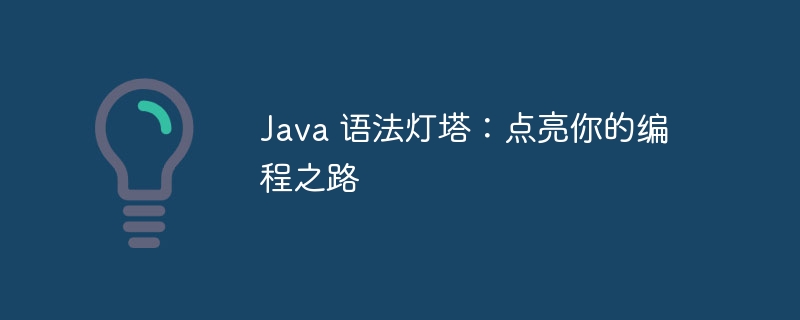Home >Java >javaTutorial >Java Syntax Lighthouse: Light up your programming path
Java Syntax Lighthouse: Light up your programming path
- WBOYWBOYWBOYWBOYWBOYWBOYWBOYWBOYWBOYWBOYWBOYWBOYWBforward
- 2024-04-03 13:07:05697browse

Java is a very popular programming language and many programmers are using it for programming work. However, for beginners, mastering the Java language is a big challenge. In this process, there are many difficulties to overcome, so there is a need for a guide to help beginners quickly become familiar with all aspects of the Java programming language. PHP editor Youzi brought you an article to share how to improve your programming abilities by learning Java syntax and programming skills. Let's take a look at the knowledge and skills provided in this article to help everyone light up their programming path.
Data types and variables
- Java provides various data types (such as int, double, String) to store different types of data.
- Variables are used to store data and are declared by type and name.
- For example:
int age = 25;
Control flow
- Java uses control flow statements (such as if-else, switch-case, for, while) to control program flow.
- These statements allow blocks of code to be executed or repeated based on conditions.
- For example:
if (age >= 18) { System.out.println("You can vote."); } else { System.out.println("You cannot vote."); }
method
- A method is a set of code blocks that perform a specific task.
- A method is defined by its name, parameter list, and return type.
- For example:
public int sum(int a, int b) { return a + b; }
Classes and Objects
-
Java uses classes and objects to organize and encapsulate data and behavior.
-
Classes define the data types and methods of objects, and objects are instances of classes.
-
For example:
class Person { private String name; private int age; public String getName() { return name; } public void setName(String name) { this.name = name; } }
Person person = new Person(); person.setName("John");
**继承和多态性**
* 继承允许子类从父类继承数据和方法。
* 多态性允许子类对象使用父类类型进行交互。
* 例如:
```java
class Employee extends Person {
private int salary;
public int getSalary() {
return salary;
}
public void setSalary(int salary) {
this.salary = salary;
}
}
Employee employee = new Employee();
Exception handling
- Exceptions are errors or unusual conditions that may occur during program execution.
- Java uses try-catch blocks to handle exceptions and take appropriate action when they occur.
- For example:
try { int result = 10 / 0; } catch (ArithmeticException e) { System.out.println("Cannot divide by zero."); }
Input and output
- Java provides various input and output streams to communicate with user interaction or files.
- For example:
Scanner scanner = new Scanner(System.in); int age = scanner.nextInt();
Best Practices
- Follow Java coding conventions (such as Camel notation) to improve code readability.
- Use comments to explain code and document your intent.
- Write reusable and maintainable code.
- Practice good version control to track code changes.
in conclusion
Mastering Java syntax is the basis for becoming a skilled Java developer. By understanding data types, control flow, methods, classes, and objects, and other syntax features, you can take advantage of the power of Java and build efficient, scalable applications.
The above is the detailed content of Java Syntax Lighthouse: Light up your programming path. For more information, please follow other related articles on the PHP Chinese website!
Related articles
See more- What does Monitor mean? Introduction to Monitor in Java
- Java Switch statement (detailed usage explanation)
- What should I do if java prompts that the main class cannot be found or cannot be loaded?
- How to refresh the page using javascript
- Vue development experience sharing: practices to improve code readability and maintainability

